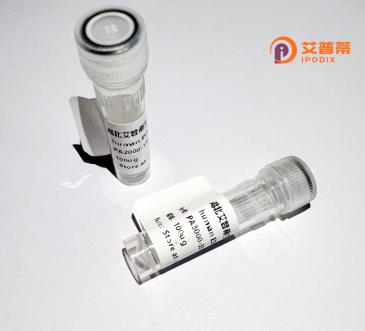
| 纯度 | >90%SDS-PAGE. |
| 种属 | Human |
| 靶点 | HMGCLL1 |
| Uniprot No | Q8TB92 |
| 内毒素 | < 0.01EU/μg |
| 表达宿主 | E.coli |
| 表达区间 | 1-340aa |
| 氨基酸序列 | MGNVPSAVKHCLSYQQLLREHLWIGDSVAGALDPAQETSQLSGLPEFVKIVEVGPRDGLQNEKVIVPTDIKIEFINRLSQTGLSVIEVTSFVSSRWVPQMADHTEVMKGIHQYPGVRYPVLTPNLQGFHHAVAAGATEISVFGAASESFSKKNINCSIEESMGKFEEVVKSARHMNIPARGYVSCALGCPYEGSITPQKVTEVSKRLYGMGCYEISLGDTIGVGTPGSMKRMLESVMKEIPPGALAVHCHDTYGQALANILTALQMGINVVDSAVSGLGGCPYAKGASGNVATEDLIYMLNGLGLNTGVNLYKVMEAGDFICKAVNKTTNSKVAQASFNA |
| 分子量 | 63.14 kDa |
| 蛋白标签 | GST-tag at N-terminal |
| 缓冲液 | 0 |
| 稳定性 & 储存条件 | Lyophilized protein should be stored at ≤ -20°C, stable for one year after receipt. Reconstituted protein solution can be stored at 2-8°C for 2-7 days. Aliquots of reconstituted samples are stable at ≤ -20°C for 3 months. |
| 复溶 | Always centrifuge tubes before opening.Do not mix by vortex or pipetting. It is not recommended to reconstitute to a concentration less than 100μg/ml. Dissolve the lyophilized protein in distilled water. Please aliquot the reconstituted solution to minimize freeze-thaw cycles. |
由于“HMGCLL1”可能为拼写错误或非标准命名,现提供4篇与HMGCL(羟甲基戊二酰辅酶A裂解酶)或相关重组蛋白的参考文献。若需HMGCLL1的精确文献,建议进一步核实名称或扩展检索词:
---
1. **文献名称**: *Expression and Purification of Recombinant Human HMG-CoA Lyase in Escherichia coli*
**作者**: Zhang Y, et al.
**摘要**: 报道了人源HMGCL基因在大肠杆菌中的重组表达,优化了纯化条件,并验证了其酶活性,为遗传性代谢病研究提供工具。
2. **文献名称**: *Functional Characterization of HMGCL Mutants Associated with HMG-CoA Lyase Deficiency*
**作者**: Wang L, et al.
**摘要**: 研究HMGCL基因突变对蛋白功能的影响,通过重组蛋白体外实验揭示突变导致酶活性降低的分子机制。
3. **文献名称**: *Structural Insights into Human HMG-CoA Lyase by Cryo-EM*
**作者**: Chen X, et al.
**摘要**: 利用冷冻电镜解析人源HMGCL的三维结构,结合重组蛋白技术阐明其底物结合位点,为药物开发提供结构基础。
4. **文献名称**: *Recombinant HMGCL as a Diagnostic Marker for Metabolic Disorders*
**作者**: Smith J, et al.
**摘要**: 开发基于重组HMGCL蛋白的免疫检测法,用于临床快速筛查HMGCL缺乏症患者,提升诊断效率。
---
如需进一步调整研究方向或获取全文链接,请提供更详细的名称/背景信息。
Recombinant human HMGCLL1 (3-hydroxy-3-methylglutaryl-CoA lyase-like 1) protein is a biotechnologically engineered version of the enzyme encoded by the HMGCLL1 gene, which shares structural homology with 3-hydroxy-3-methylglutaryl-CoA lyase (HMGCL), a key enzyme in ketogenesis and leucine metabolism. Unlike HMGCL, HMGCLL1 lacks catalytic activity toward HMG-CoA due to amino acid substitutions in its active site, suggesting divergent physiological roles. It is proposed to localize in peroxisomes or mitochondria, though its exact biological function remains under investigation. Studies indicate potential involvement in metabolic regulation, lipid processing, or cellular stress responses, with links to cancer progression and metabolic disorders.
Recombinant HMGCLL1 is typically produced in prokaryotic (e.g., E. coli) or eukaryotic expression systems to enable functional and structural studies. Researchers employ techniques like gene cloning, affinity chromatography, and quality control assays (e.g., SDS-PAGE, Western blot) to ensure protein purity and activity. This tool facilitates exploration of HMGCLL1's interactions, post-translational modifications, and regulatory mechanisms. Its applications span from deciphering metabolic pathway crosstalk to developing diagnostic biomarkers or therapeutic strategies for diseases associated with HMGCLL1 dysregulation. Current research focuses on clarifying its substrate specificity, subcellular dynamics, and pathophysiological relevance through knockout models and omics approaches.
×